Copper Highlights Resource Conservation House
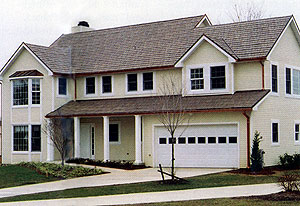 NAHB Resource Conservation House. Flashing, drip edges, bay window roofs, gutters and drains, wiring and all plumbing are copper.
NAHB Resource Conservation House. Flashing, drip edges, bay window roofs, gutters and drains, wiring and all plumbing are copper.New and clever uses of copper stimulate ideas in the builders and architects visiting the Resource Conservation House. And, since the innovative model home was officially opened last December, many hundreds have requested brochures describing the energy-saving and resource-conserving measures in the house.
The Resource Conservation House is a project of the National Association of Home Builders Research Center. It is located along with three other "concept" homes about one mile from the Center's headquarters in Upper Marlboro, Maryland. The Copper Development Association cooperated with NAHB in its design and construction. Many member companies of CDA contributed materials to the house, which has earned CDA's "Copper Quality Award."
Major uses of copper in the home are:
- Direct-coupled ground-source heat pump
- Solar water-heating system
- Photovoltaic electricity generator
- Automatic fire sprinkler system
- Flashing, drip edges, gutters and drains
- Electrical cabling
- Plumbing, including the tubing that delivers natural gas.
In addition, bay windows are roofed with sheet copper and most of the building hardware and many of the lighting fixtures are made of solid brass. All door hinges are made of bronze and the fireplace screen is framed in brass.
Direct-coupled Ground-source Heat Pump
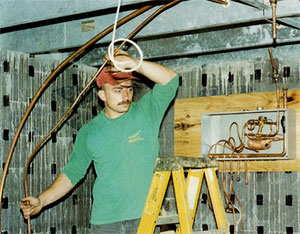 Copper tubes which aid the energy efficiency of the earth-coupled heat pump are buried five feet deep in the backyard. The 50-foot-long loops exit through an opening in the basement behind the ladder and reenter through openings a foot lower. They are tied to the heat pump through the connection box (uncovered here) in the center of the wall.
Copper tubes which aid the energy efficiency of the earth-coupled heat pump are buried five feet deep in the backyard. The 50-foot-long loops exit through an opening in the basement behind the ladder and reenter through openings a foot lower. They are tied to the heat pump through the connection box (uncovered here) in the center of the wall.The super-efficient heat pump is coupled to the earth via copper tube (see photo below). Four 50-foot-long loops of copper tube, graduated from a 3/8 to 5/8 - inch diameter, are buried about five feet deep in the backyard. The loops contain R22, an environmentally approved refrigerant that absorbs heat from the earth in winter and conducts heat from the home to the earth in summer.
On the 100 F day this reporter visited the home, it was cool (to the point of being chilly). The supplier of this system is Earth Systems International Inc. of Kitchener, Ontario, Canada.
Earth Systems: 800/463-2784
Solar Water Heater
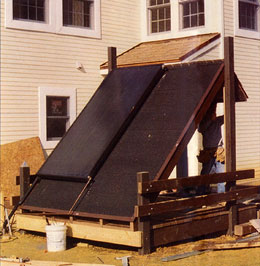 The glass-covered backyard solar-energy collector. Copper tubes absorbing the sun's heat are in the left half. Photovoltaic cells in the right segment charge storage batteries that power the landscape lights and security system.
The glass-covered backyard solar-energy collector. Copper tubes absorbing the sun's heat are in the left half. Photovoltaic cells in the right segment charge storage batteries that power the landscape lights and security system.The two-part solar-energy collector (for water heating and electricity generation) is in the backyard instead of on the roof so it could be oriented for maximum exposure to the sun. Its frame also supports a child's swing. The system is made by American Energy Technologies, Inc., Green Cove Springs, Florida.
One half of the solar collector circulates a solution through black chrome-plated copper tubes where it is heated by the sun's energy and then carried inside the home to a heat exchanger. The exchanger, which transfers the heat to the water heater, is needed because the solution in the collector contains an antifreeze. This protective feature prevents the nontoxic propylene glycol from entering the water supply.
The other half of the solar energy collector contains photovoltaic cells that charge several big batteries in the garage. Together, they provide enough power for the outdoor lamps and the security system. In the event of an electrical utility failure, the batteries can power emergency lights inside the home.
American Energy Technologies, Inc.: 800/874-2190
Residential Fire Sprinkler System
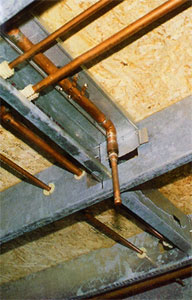 The automatic fire sprinkler system, made of copper tube and fittings, protects the entire house and garage from damage due to fire. Systems such as this provide safety and peace of mind to new homeowners throughout the U.S., with installed costs of about $1.25 per square foot or less. Prince George's County, where NAHB's prototype homes are situated, is one of the nation's growing number of jurisdictions that requires sprinkler systems in new homes.
The automatic fire sprinkler system, made of copper tube and fittings, protects the entire house and garage from damage due to fire. Systems such as this provide safety and peace of mind to new homeowners throughout the U.S., with installed costs of about $1.25 per square foot or less. Prince George's County, where NAHB's prototype homes are situated, is one of the nation's growing number of jurisdictions that requires sprinkler systems in new homes.
Recycling Center
In keeping with the home's concept, the kitchen is equipped with a "recycling center." The center is mounted in a spring-activated drawer under the sink and contains two receptacles for plastic bags: one for discarded paper and the other for cans and bottles. The center slides out when a foot pedal is depressed. To accommodate the recycling center, the plumbing under the sink had to be shifted as shown in the accompanying photo. All the plumbing is copper.
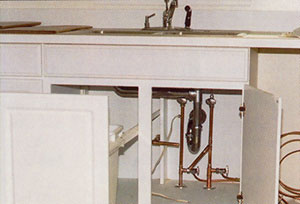 Copper plumbing was installed in the right half of the space under the sink to accommodate the drawer-like recycling center in the left half.
Copper plumbing was installed in the right half of the space under the sink to accommodate the drawer-like recycling center in the left half.Also in this Issue:
- Copper Alloy Essential to Bloodless Surgery
- Copper Highlights Resource Conservation House
- More Copper Equals Big Energy Savings
- Copper and Brass Strengthen Stained Glass
